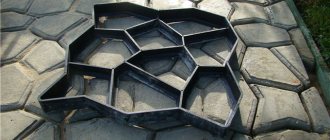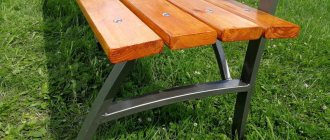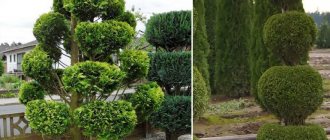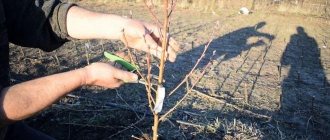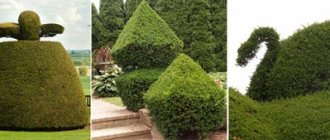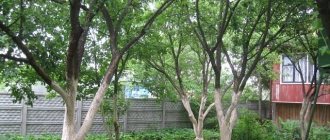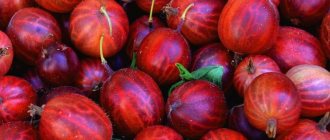What you need to know to successfully master pruning techniques
Pruning trees and forming a crown is a serious matter, but if desired, everyone can understand the principles, understand the essence of the process and achieve compactness, large-fruitedness, and productivity from their apple trees.
Of all the activities carried out in the garden, perhaps the most difficult, especially for beginner gardeners. Pruning a fruit tree is nothing more than a surgical intervention in its Organism, and the slightest mistakes made in this case, especially in relation to newly planted young trees, are fraught with serious consequences.
The need for systematic and consistent formation of the crown of a young tree is justified by the fact that an adult tree, in our case an apple tree, must have sufficient strength of fusion of the branches of the crown with the central conductor, good lighting of all their sections, which contributes to the formation of fruits not only on the outside, but also on the inside crown zone.
In addition, in order to increase the density of plantings, improve the convenience of caring for the crown and harvesting the crop, it is necessary to choose a formation system such that even mature trees are of small height with a low-volume crown.
In practical gardening, various systems for forming fruit trees are common, but the most accessible and at the same time universal crown for amateur gardeners is a small-sized sparsely tiered crown.
Decorative qualities of fruits
Fruits are a very effective addition to decorative plants. For this purpose, targeted hybridization and selection of plants are carried out, especially among fruit plants with highly decorative fruits.
The decorative effect of fruits is determined by their size, shape, color, ripeness and falling from the plant. The bright colors of large or small fruits that densely cover the crown look especially beautiful against the background of green leaves.
Hanging clusters, bunches, fruit heads, pods, cones and cone berries (for conifers) look original. The fruits and seeds of woody plants often have hairs and bristles, which can not only increase their decorative value, but also cause some harm to the environment (willow, poplar). However, the taste of fruits does not always contribute to the preservation of the decorative properties of plants.
Basic crown shapes
Small-sized sparsely-tiered crown
It is recommended as the main formation for plantings on both vigorous and weak-growing rootstocks. In this case, the crown is formed, as a rule, from 5 skeletal (main) branches of the first order on a trunk 60-70 cm high.
In the lower part, a tier is created from two adjacent or close, oppositely located branches. Others are located sparsely with an interval between the lower tier and the third branch of at least 60 cm, the rest - after 30-40 cm. The upper branch (5th or 6th) is laid at a height of 1.8-2.1 m.
Semi-skeletal branches 1-2 m long are formed on the skeletal branches. They are placed singly or in groups of two or three, on the lateral and outer sides of the main branches. Between groups of semi-skeletal branches, an interval of 40-60 cm is maintained.
Skeletal branches are placed at an angle of 40-45° to the row line, which allows you to create a more convenient shape, flattened on the row-spacing side, reduce the row-spacing width and increase the density of plants per unit area. The specified formation system makes it possible to limit the height of trees to 2.5-3.0 m.
The sequence of formation of a sparsely-tiered crown (in the second to fourth year after planting): on the left - before pruning, on the right - after pruning
Semi-flat crown
The crown consists of a well-developed central conductor and 4-6 skeletal branches of the first order, directed at an angle of no more than 30° to the row line.
The lower tier is laid from two oppositely located branches, between which a height interval of 20-30 cm is acceptable. The remaining branches are placed sparsely along the trunk. The third branch is laid at intervals of at least 60 cm, subsequent ones - after 40-50 cm. As a result, the semi-flat crown forms fruit walls 3.0-3.5 m wide and 2.5-3.5 m high.
Rounded spindle-shaped crown
The crown is formed from lateral branches evenly spaced around the central conductor. The lower tier consists of 5-7 branches, which, in order to weaken growth, are given a slope of 25-35° to the horizons. With a smaller number of branches in the first tier, they become excessively strong; with a larger number, they do not reach the required size and sag greatly under the weight of the fruit.
The number of branches in subsequent tiers may be greater than in the lower tier, or less. To weaken growth and enhance reproductive functions , they are given a horizontal or slightly elevated position. Crown parameters depending on growth vigor, rootstocks and varieties: height 2.5-3.5 m, width up to 3.5-4 m.
The fully formed crown in the lower part has small openings on the row-spacing side, which make it more convenient for trimming and cleaning blankets. Making openings in the crown is carried out by spreading the branches growing between the rows to the sides, fixing them in this position with a garter and using pruning for transfer.
Spindle-shaped crown
Flat spindle-shaped crown
Recommended for extensive production testing. It consists of a well-developed central conductor and two strong, oppositely located skeletal branches, forming a palmettic layer, and semi-skeletal branches. Skeletal branches and the bulk of semi-skeletal branches are formed in the plane of the row.
To slightly weaken growth, enhance branching and stimulate fruiting, the skeletal branches are given a tilt of 55-60° from the vertical, and the semi-skeletal branches located higher along the conductor are given a horizontal or slightly elevated position. The height interval between the main branches is 20-30 cm.
Semi-skeletal branches, depending on the shoot-forming ability of the varieties and their divergence in space, are placed on the sides of the central conductor every 20-40 cm. In varieties with pronounced tiered growth, these branches are placed in tiers of 4-6 in each. In this case, an interval of 40-45 cm is required between tiers.
The length of skeletal branches growing along the row line, depending on the growth strength of the rootstocks and the density of trees in the row, can reach 1-1.8 m in the lower part of the crown, and 0.7-1.5 m in the upper part. The length of semi-skeletal branches, growing towards row spacing is limited by the accepted thickness of the fruit wall. As the crowns grow, branches of this orientation are gradually removed into a ring or transferred to branches growing along the line of the row.
Decorative qualities of flowers
When choosing woody plants for ornamental plantings, flowers are sometimes of decisive importance. The decorative qualities of flowers include their structure, size, shape, color and smell.
By size, the flowers of woody plants are divided into very large - with a diameter of more than 10 cm (large-leaved magnolia), large - with a diameter of 5-10 cm (Japanese and Chinese camellia), small - with a diameter of 2-5 cm (rhododendrons, cherries), small - with a diameter of up to 2 cm (bird cherry, meadowsweet, etc.).
The decorative effect of flowers is also determined by the size, shape, structure and color of the petals, stamens, and bracts. Flowers of woody plants can be of various colors and shades: white, yellow, orange, red, pink, green, blue, indigo, violet and purple.
Among the woody plants that are used in gardening and park construction, there are many whose flowers are not highly decorative and whose inflorescences are insignificant. These include most species of willow, poplar, birch, oak, elm, maple, walnut, as well as hornbeam, hazel and beech.
When creating landscape gardening compositions, the period and duration of flowering of woody plants is important. According to the flowering period, they are divided into those that bloom in early spring, spring, summer, autumn and winter.
According to the duration of flowering, woody plants are divided into long-flowering plants - the flowering period of flowers is more than one month (dropping hydrangea), plants with an average flowering period - a flowering period of up to one month (tree hydrangea), plants with a short flowering period - 1-2 weeks (Robinia pseudoacacia) .
The onset and continuation of flowering in woody plants largely depends on the climatic conditions in which they grow. Therefore, not only in different geographically designated areas, but in the same locality in different years, the beginning and continuation of flowering of plants is slightly different.
To use flowering woody plants in ornamental plantings, it is necessary to take into account the age of the plants at which they begin to bloom, and the fertility of the soil, on which the beginning and density of flowering of plants depends.
The order and technique of pruning
Tree pruning during the period of crown formation should be minimal and intensify as harvests increase and growth processes weaken.
Correct cuts of branches
This means that with the minimum necessary alienation of wood, completed and well-made crowns are obtained in the shortest possible time, with maximum growth rates of leaf surface and fruit wood. This is achieved through extensive use of inclination of skeletal and semi-skeletal branches and limitation of cutting.
At the same time, pruning the central conductor in order to obtain branches at the required height, shortening the main branches (at an optimal angle of inclination) to enhance branching or subordination, cutting out competitors that cannot be tilted, vertical shoots and branches with sharp branching ears must be done very carefully .
A faster growth of leaf surface and fruit wood in many formations is facilitated by leaving temporary branches on the central conductor. But this is permissible only in varieties whose branches sharply blunt their growth when they are transferred to a horizontal or slightly drooping position and do not form a significant number of tops. In varieties such as Pepin Saffron, Osenneye Polosatoe and others that respond poorly or not at all to tilt, it is not advisable to leave temporary branches.
Anti-aging pruning of trees begins when the length of the terminal growths of skeletal and semi-skeletal branches becomes less than 25-30 cm. The first anti-aging pruning is carried out on two- to three-year-old wood. In terms of its strength, such pruning in the first years of fruiting is quite sufficient to maintain active growth and obtain high-quality fruits. As harvests increase and trees age, it intensifies and is carried out on “older” wood with an annual growth length of at least 40 cm.
In full-aged plantings, as the crowns thicken, rejuvenating pruning is combined with cutting out the least valuable branches to improve the radiation regime of the crowns. When carrying out anti-aging pruning, the principle of subordination of branches in the crown must be strictly observed in order to preserve, and in some cases improve its shape and design.
The main feature that determines the timing of the beginning of limiting the height of trees in plantations with round and semi-flat formations is the natural opening of the crown, which usually occurs after two or three abundant harvests, when the tops of the branches deviate quite far from the central conductor.
In plantations with round and semi-flat formations, the method of limiting or reducing the height of trees should be preceded by opening the center of the crowns.
The central conductor is cut out at the accepted height with a “protective link”; strong vertical branches and branches in the center of the crown are also cut out. Carrying out this technique improves the radiation regime in the central part of the crowns, reduces the number of strong vertical restoration increments in the cutting area of the branches.
In order to reduce the activity of restoration processes in the upper part of the crowns, pruning to limit the height of trees is best done in late spring or early summer.
Choosing a landing site
Choosing where to plant on the plan is just as important as the placement of the rest of the garden elements. Trees take up space, and therefore cover the garden and create a feeling of security. They should be selected and placed on the site with great care.
Before choosing a particular type of tree, you need to clearly imagine what effect a certain tree will produce with the shape of the crown and leaves, their shade, etc.
The designer should clearly imagine how a tree with a spherical or dome-shaped crown, for example, hawthorn or maidenhair, will look on the site, then try to imagine a tall, slender plant with a vertical shape, such as Irish yew.
Each of these trees will be perceived differently, and the deciding factor should be the perception of the outline of the tree without foliage.
You should not study the catalog with plants until the issue of choosing plantings has been resolved, otherwise the number of plants offered may lead to confusion. Shade, size, leaf texture, trunk, bark, maximum height, volume and rate of growth, density of the crown and its ability to transmit light - all this should be taken into account.
Formation of the crown of a young apple tree
Fruit nurseries and gardening associations sell planting material of pome-bearing species (apple, pear), usually at two years of age.
The two-year-old tree is planted in a permanent place in the garden in such a way that the main (skeletal) branches of the first tier of the future tree (no more than three) are located at an angle of 30-45° to the row line. In the spring of the first year, carefully monitor the angles of separation of the branches from the central conductor (50-55°) and the angles of their divergence (90-120°). To do this, use spacers and twine. Briefly, the competitor, if any, is shortened by 4-5 buds; later (after 1-2 years) it is removed.
The first minimal pruning of planted trees is carried out in early spring, in the second year of planting, in order to coordinate the branches.
Pruning begins with the least developed branch, chosen as the main one in the lower tier. They are cut to 1/4-1/3 of its length, so that it is at least 40 cm. The remaining branches of the first tier are cut at the same level. Particular attention is paid to the choice of the bud along which the cut is made. Pruning technique is equally important. Varieties with a pyramidal crown are pruned to the bud located on the outside, and with a spreading crown - to the bud located inside.
The cut is made above the selected bud, leaving a spine 1.5-2 cm long, which will dry out and fall off within 1-2 growing seasons. By doing this, we guarantee the safety of the bud , from which a further shoot grows during the growing season, which is not always achieved when cutting directly above the bud. This rule only applies when pruning annual shoots.
They often resort to another technique. Varieties with a pyramidal crown (Northern Sinap, Anise, etc.), despite everything, are pruned to a bud located inside the crown, and the next year they are pruned to a shoot that grew from a bud located outside, thereby achieving the greatest effect in opening the crown.
In varieties with a wide crown (Pepin Shafranny, Berkutovskoe, Zhigulevskoe, etc.) it is the other way around: first, the cut is made on the outer bud, and then on the shoot that has grown inward, achieving a more compact structure of the tree crown. The central conductor is cut 15-25 cm above the level of the branches in the tier. The predominance of the conductor is less in varieties with a spreading crown, and greater in those with a pyramidal crown.
The cut of the central conductor is carried out over a well-developed bud, located in such a way that the continuation shoot that grows from it further ensures its straightness, preventing or correcting its curvature.
Approximate diagram of pruning a young apple tree at the beginning and end of crown formation
All other branches not selected as the main ones are under no circumstances removed and, as a rule, are not cut short, but are left in the tree, but are not given the opportunity to compete in the vigor of the main branches. To do this, various techniques are used to weaken the growth of branches : increasing the angle of deviation from the central conductor by tying them with twine to a horizontal position, intertwining them with each other, placing them under a stronger branch, deformation (careful repeated bending of the branch until the wood crunches and the bark slightly ruptures).
These temporary branches are needed to quickly increase the area of leaves on the tree, which will contribute to the better development of the young tree and its rapid entry into fruiting. The first fruits will be obtained precisely on weakly growing branches, which are covered with short branches turning into fruit formations (rings, spears, fruit twigs).
The twine used for shaping is tied on the branches and trunk of the tree in a figure eight to prevent them from becoming overtightened, and after 1.5-2 months or even next year, it is removed. Over the next 5-6 years, and sometimes more, the crown of the tree continues to be formed annually, maintaining the subordination of the branches among themselves and with the central conductor, trying, if possible, to withstand the requirements of a sparsely-tiered crown.
Angles of departure of the main skeletal branches: 1 - unacceptable: too sharp an angle (less than 45°); 2 — permissible angle (45°); 3 - good angle (60°); 4 - permissible, right angle; 5 - unacceptable obtuse angle
Depending on the chosen planting scheme (nutrition area), the crown of an adult tree can have from 4 to 6 main branches.
It is advisable to place rows of trees on seed (vigorous) rootstocks at a distance of 6 m, and between trees in a row - 3.5 m. Deviations of 1 m in the distance between rows and 0.5 m between trees are possible, of course, in the direction of decreasing or increase. With a small feeding area , 4 main branches are formed, with a large one - 5-6 branches, which have a strong but uniform development in length (3-3.5 m) and a thickness equal to 0.5 of the thickness of the Central conductor.
A large number of semi-skeletal branches are formed on the main branches, placing them 30-40 cm apart from each other, in pairs or singly, in a position close to horizontal, 1-1.5 m long. The same branches are formed on the central conductor. They quickly become covered with small overgrowing branches, lay fruit buds and promote increased fruiting.
In the future, when the crown thickens (after 10 years), they can be gradually thinned out . The lower tier is laid from 2 branches, the subsequent main branches are placed as follows: the third branch, or the second tier of 2 branches, can be laid at a distance of 60 cm from the lower tier, and the subsequent ones with an interval of 30-40 cm - sparsely. The upper branches are placed above the lower ones, maintaining sufficient divergence angles.
Decorative qualities of leaves
The decorative appearance of woody plants largely depends on the shape (ornament), size, color and placement of leaves on the branches. These qualities of woody plants can enhance or reduce the effect of the entire composition of green spaces.
And therefore, it is an important decorative element in the selection of plants for creating single and group plantings, building perspective and contrasting color schemes in park compositions.
Leaves consist of a leaf blade, a petiole, a leaf sheath and stipules. Some leaves may be missing parts. The place where the leaf is attached is called a node, and the distance between the nodes is called an internode.
The leaves of woody plants differ from each other in structure, venation, serration of leaf edges, shape and color.
The structure of the leaves can be simple or complex. The shape of simple leaves is rounded, oval, ovate, obovate, oblong, lanceolate, needle-shaped, etc.
In some plants, among the complex leaves there are: trifoliate, palmate and pinnate. With age, the structure, shape and edge of leaves in woody plants may change.
By size, the leaves of woody plants are divided into very large (catalpa), large (sycamore), medium (oak), small (white willow), very small (boxwood).
It should be noted that among coniferous plants there are also plants with very large, large, medium, small and very small needles.
The decorative effect of a leaf of woody plants and the entire plant depends on its texture, i.e. leaf surface. It can be smooth, matte, rough, pubescent, humpbacked, spiked, glossy, shiny.
At different times of the year in evergreens and throughout the growing season in deciduous woody plants, the color of the leaves is of great decorative importance. Most often they are green in color with varying shades from light to dark green.
Knowledge of the structure, timing of blooming and falling, color and change in color of leaves allows specialists to solve many tasks of gardening and park construction and create highly decorative and spectacular compositions from woody plants.

